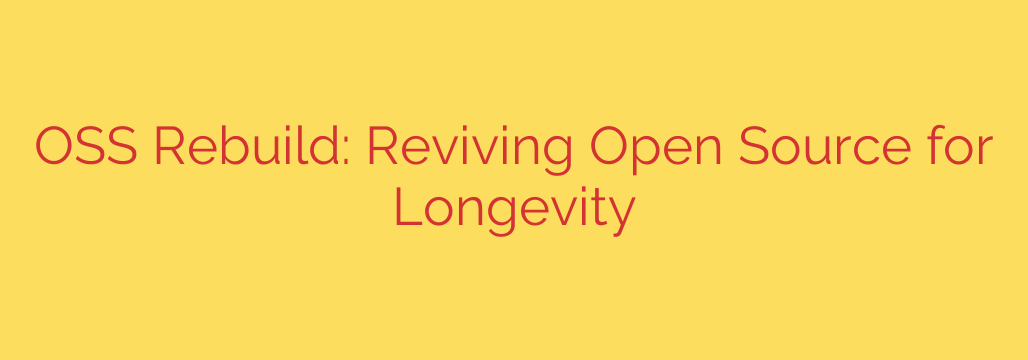
Beyond the Code: Why We Must Rebuild Open Source for a Secure Future
Open source software (OSS) is the invisible engine powering our digital world. From the operating system on your phone to the servers that host your favorite websites, OSS provides the fundamental building blocks of modern technology. For decades, it has thrived on a model of community collaboration and shared innovation. However, recent events have exposed deep cracks in this foundation, revealing a growing crisis of sustainability and security that demands our immediate attention.
The very model that made open source great—its accessibility and reliance on volunteer effort—has become its greatest vulnerability. We can no longer afford to treat critical digital infrastructure as a free resource without investing in its long-term health and security.
The Core of the Crisis: Burnout and Security Gaps
At the heart of the open source ecosystem are maintainers—the dedicated individuals who write, update, review, and secure the code. Many of these developers are unpaid volunteers, contributing their nights and weekends to projects used by multi-billion dollar corporations.
The result is widespread maintainer burnout. When a handful of people are responsible for maintaining a piece of software used by millions, the pressure is immense. Bug reports, feature requests, and security patches create an endless stream of work. Without financial support or institutional resources, many maintainers are forced to step away, leaving projects under-maintained or completely abandoned.
This directly fuels a second, more dangerous problem: a widening software supply chain security gap. Under-resourced projects simply cannot keep pace with the sophisticated threats emerging every day. We saw this with the Log4j vulnerability, a flaw in a ubiquitous logging library that sent shockwaves through the industry. More recently, the xz Utils backdoor provided an even more chilling lesson.
The xz Utils Incident: A Wake-Up Call for the Entire Industry
The near-catastrophic xz Utils incident was not a simple bug; it was a deliberately executed, multi-year social engineering attack. A malicious actor patiently gained the trust of a lone, overworked maintainer, became a co-maintainer, and then inserted a sophisticated backdoor into the code.
This backdoor, if it hadn’t been discovered by a vigilant engineer, would have compromised countless Linux systems worldwide, allowing for remote code execution. The incident proved a terrifying point: a single, under-supported project in your software supply chain can become a gateway for a global security breach. Trust is not a security strategy.
A Path Forward: Verifiable and Reproducible Builds
To secure the future of open source, we must move beyond simply trusting the code we download. The key lies in verification and transparency, and one of the most powerful tools to achieve this is the reproducible build.
A reproducible, or deterministic, build is a process that ensures anyone can take the public source code for a piece of software and compile it in a way that produces a bit-for-bit identical binary file.
Why is this so important?
- It Verifies Integrity: If you can independently rebuild a project and your version matches the official release, you can be certain the code hasn’t been tampered with between the source and the final product. The xz Utils backdoor would have been much harder to hide in a project that enforced reproducible builds.
- It Exposes Malice: It prevents a scenario where a project’s public source code is clean, but the pre-compiled version distributed to users contains hidden malware.
- It Builds a Chain of Trust: Reproducible builds allow for independent verification, shifting the security model from blind trust in a maintainer to provable cryptographic certainty.
Implementing reproducible builds across the ecosystem is a significant technical challenge, but it is a necessary step to fortify our digital infrastructure against sophisticated supply chain attacks.
Actionable Steps to Secure Our Shared Ecosystem
The responsibility for fixing this problem does not fall on the shoulders of volunteer maintainers alone. It is a shared responsibility across the entire technology industry.
For Corporations and Organizations: Companies that build their products and profits on OSS have a duty to contribute back. This means more than just using the code; it means actively supporting its health.
- Fund Critical Projects: Financially support the open source projects you depend on through platforms like Open Collective or by directly sponsoring foundations like the Open Source Security Foundation (OpenSSF).
- Contribute Engineering Time: Dedicate employee time to help maintain critical dependencies, fix bugs, and review code.
- Audit Your Dependencies: Regularly scan and audit the open source libraries in your products. Understand what you are using and assess the health of those projects.
For Developers:
- Advocate for Reproducible Builds: Push for deterministic build processes within your own projects and organizations.
- Be a Good Citizen: When you use an open source library, contribute back by reporting bugs clearly, submitting well-written pull requests, and participating in community discussions.
- Vet Your Dependencies: Before adding a new library, investigate its maintenance level, community activity, and security history.
Open source software is too important to fail. The era of passive consumption is over. By embracing a new model of shared responsibility, investing in maintainer sustainability, and adopting technical safeguards like reproducible builds, we can ensure that the open source ecosystem remains a vibrant, innovative, and—above all—secure foundation for the future.
Source: http://security.googleblog.com/2025/07/introducing-oss-rebuild-open-source.html








